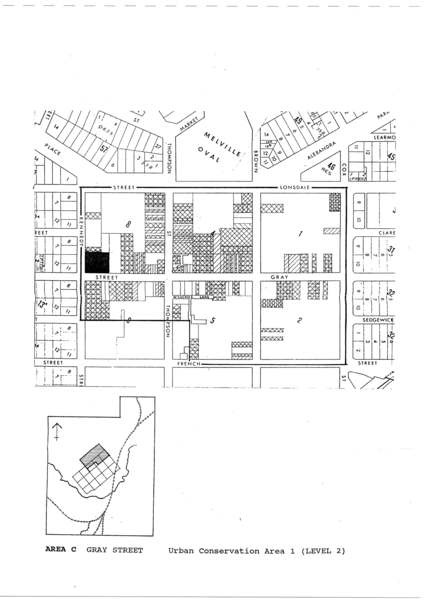Gray St Commercial Precinct Hamilton
HAMILTON, Southern Grampians Shire
-
Add to tour
You must log in to do that.
-
Share
-
Shortlist place
You must log in to do that.
- Download report


Statement of Significance
-
-
Gray St Commercial Precinct Hamilton - Physical Description 1
The character of the Gray Street Commercial area is dominated by the strict street grid. Its main axis is Gray Street which soon took precedence in a commercial sense over the lower lying Lonsdale Street. It has remained the centre of Hamilton ever since. It had been almost completely built up by the 1900s, certainly to the street frontages but was not nearly so developed at the rear of the sites, access from the main streets being limited. This means that even now there are large areas, mostly devoted to carparking, behind the facades in Gray, Thompson, Lonsdale, Brown and Cox Streets.
Since the 1900s there has been steady redevelopment with a particularly important legacy surviving in the buildings from the 1930s. The most important change was prompted by the Council in the 1960s and is now generally regretted by everyone. The Council adopted a policy of removing post-supported verandahs. The early views of Hamilton which survive in photographs show clearly how important they were in creating the character of the commercial streets. It is important to distinguish between the original post-supported verandahs in front of buildings constructed before the First World War and the "authentic" cantilevered verandahs of the building constructed in the thirties and later.
The next phase of re-development was the cladding of the 1980s. There are many buildings surviving, probably quite intact, behind new parapets and first floors faced with sheet steel used as a cheap way to modernise them. The other important change to have occurred over the years is the modernization of shop fronts. Each of the streets still enjoys a healthy variety of periods and therefore styles but many of the original shopfronts have been replaced by inappropriate alternatives. There are other superficial changes to buildings all of which can be attributed to the desire to modernize.
The early photographs show that there were no trees in Gray and Thompson Streets originally. The streets then were unmade and either dusty or muddy depending on the season. The gutters were wide spoon drains and were built up with bluestone pitchers. Paving seems to have varied but one photograph taken outside the Victoria Hotel shows bluestone flags on the gutter half of the footpath area. The other half beside the buildings must have been unsealed. It has been said that concrete flags were laid at one time. Asphalt would have been used at a later stage and was probably the material which was replaced by the present brick paving.
The new brick paving is now everywhere in the Gray Street Commercial area. It serves to unify the area. While its advantages were clear when it was first laid down some of its disadvantages are now revealing themselves especially the bad wear-and-tear. The paving is matched by brick planter boxes in Gray Street which are filled with low shrubs. These are generally well maintained and successful. There are Platinus X acerifolius, Planes, in the roadway which are in good condition and contribute significantly to the quality of the streetscape. They provide much needed shade, a restful atmosphere and a sense of scale. They continue the traditional planting of the residential parts of Gray Street. Elsewhere in the Gray Street Commercial area the plantings, Pittosporum eugenoides `Variegata', are in tubs and are not successful.
More than any other area in Hamilton the Gray Street Commercial area is filled with street furniture. Much of it seems necessary for our late twentieth century lifestyle centred, as it is, on the motor car. Even though there is a fashion to remove cars and pedestrianise commercial areas, their presence does provide not just access but also a sense of vitality and even competition with the pedestrians. The key is to establish a balance or an equal chance - usually by handicapping the car.
The municipal buildings form a small sub-group within the area. The street is planted with Platinus X acerfolius, Planes, which create a special atmosphere with their dappled light. One of the most serious losses to the Gray Street Commercial area was the demolition, more or less without real reason, of the first Town Hall in Gray Street next door to the Post Office. This left a gap in the streetscape which must be filled. It is rarely appropriate to reconstruct buildings but in this case, considering the sensitivity of the adjacent buildings and the excellent records which survive, reconstruction is a valid option. ([1]) Such a reconstruction could be flexible in its internal disposition.[1] The original drawings are held by the Hamilton Historical Society and many photographs show the building.
Heritage Study and Grading
Southern Grampians - City of Hamilton Conservation Study
Author: Timothy Hubbard with Carlotta Kellaway & Michael Looker (plus Francis Punch)
Year: 1991
Grading:
-
-
-
-
-
MECHANICS INSTITUTE
 Victorian Heritage Register H2171
Victorian Heritage Register H2171 -
HAMILTON BOTANIC GARDENS
 Victorian Heritage Register H2185
Victorian Heritage Register H2185 -
HAMILTON GAS HOLDER
 Victorian Heritage Register H1086
Victorian Heritage Register H1086
-
-









